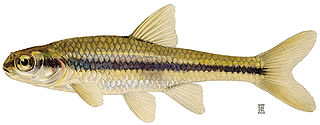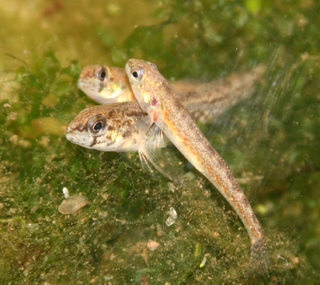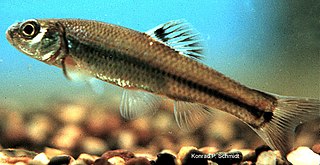
Minnow is the common name for a number of species of small freshwater fish, belonging to several genera of the families Cyprinidae and Leuciscidae. They are also known in Ireland as pinkeens.

The loach minnow is a species of freshwater fish. It is a member of the carp family of order Cypriniformes. It occurs in streams and small rivers throughout the Gila River and San Pedro River systems in Arizona, New Mexico, and Sonora; it is now considered extinct in Mexico.

The Caribbean roughshark is a rough shark of the family Oxynotidae, found on the upper continental slopes of the Caribbean Sea, at depths between 400 and 450 m. It reaches a length around 50 cm (20 in).

Fathead minnow, also known as fathead or tuffy, is a species of temperate freshwater fish belonging to the genus Pimephales of the cyprinid family. The natural geographic range extends throughout much of North America, from central Canada south along the Rockies to Texas, and east to Virginia and the Northeastern United States. This minnow has also been introduced to many other areas via bait bucket releases. Its golden, or xanthic, strain, known as the rosy-red minnow, is a very common feeder fish sold in the United States and Canada. This fish is best known for producing Schreckstoff.

The sheepshead minnow, also known as sheepshead pupfish, is a species of ray-finned fish in the family Cyprinodontidae, the pupfishes. It is found in salt marsh and estuary environments and is native to the eastern coasts of North and Central America.

Phenacobius, the suckermouth minnows, is a genus of cyprinid fishes endemic to the United States. Historically the suckermouth minnow was not found as far eastward as Ohio, now they seem to be a stable species living throughout the Midwest and parts of southern states such as Texas, New Mexico, and Alabama. Many forests and prairies were cleared out to make farmland, this caused for drainage streams and rivers to take form, moving the minnows eastward. Originally the suckermouth minnows probably never crossed the Mississippi River prior to the developed farm land. They have a lifespan of roughly 3–5 years, but is hard to measure due to predation, survival rate of about 50 percent. There are currently five described species. Etymologically, "phenacobius" means "deceptive life", possibly because these species eat insects despite an herbivorous appearance.
The Sandhills chub is a species of freshwater fish in the family Cyprinidae of order Cypriniformes. There are 4 species of Semotilus, 2 of which occur in South Carolina. This fish is found only in North Carolina and South Carolina. The Sandhills chub is predominately found in the Carolina Sandhills and some areas of Cape Fear, Pee Dee and Santee river drainages. It is characterized by its robust body, large head and lack of a dark blotch or smudge on their dorsal fin which is present on the closely related Creek Chub. The Sandhills chub has fine scales, a pinkish body and can be up to 9.4 inches.

The bridle shiner is a member of the minnow family (Cyprinidae). This species has been identified as being of Special Concern by the Committee on the Status of Endangered Wildlife in Canada (COSEWIC).

The hornyhead chub is a small species of minnow in the family Cyprinidae of order Cypriniformes. It mainly inhabits small rivers and streams of the northern central USA, up into Canada. The adults inhabit faster, rocky pools of rivers.

The pugnose shiner is a species of ray-finned fish in the genus Notropis. It is in the family Cyprinidae which consists of freshwater carps and minnows. Cyprinidae is the largest fish family which consists of about 369 genera and 3,018 species. Its distribution has been decreasing due to the removal of aquatic plants in order to create swimming beaches and boating access in freshwater lakes and is now mostly found in Minnesota, Wisconsin, and Michigan.
The carmine shiner is a freshwater fish species. In Manitoba, it was once known as the rosyface shiner. Based mostly on zoogeographic data, it is currently classified as a distinct species within the rosyface shiner species complex. The carmine shiner is a member of the Minnow family, Cyprinidae. It has the following characteristics and distinguishing features:

Western blacknose dace is a common species of ray-finned fish belonging to the family Cyprinidae and the genus Rhinichthys. Western blacknose dace have tan to dark brown backs, lighter sides, and cream colored undersides. Dark blotches are sporadically scattered across their sides and backs. A distinctive dark colored mid-lateral stripe from the tip of the snout to the caudal peduncle is present. The snout is relatively long and they have a slightly sub-terminal mouth. The stripe is dark brown in females and is a rusty pink color in males during spawning season. The lateral stripe is more pronounced and the caudal spot is present in juveniles. Similar to other species of dace the western blacknose dace give the illusion of having no scales but in actuality the scales are so small they are hard to see. Western blacknose dace are typically 2-3 inches long but can grow to as long as 4 inches. They have a forked tail, single dorsal fin with 8 rays and no spines, a pelvic fin on the abdominal, no adipose fin, and an anal fin with 7 rays and no spines.

The Chihuahua shiner is a species of freshwater ray-finned fish from the family Cyprinidae, the carps and minnows. It is found in southern Texas and northern Mexico.

Etheostoma exile, the Iowa darter, is a species of freshwater ray-finned fish, a darter from the subfamily Etheostomatinae, part of the family Percidae, which also contains the perches, ruffes and pikeperches. It is, along with about 17 other species of darters, is native to the lakes and streams of Iowa.

The scarlet shiner is a freshwater fish native to the eastern United States.

The bullhead minnow is a species of freshwater demersal fish, native to the Mississippi River system in the United States, to tributaries of Lake Huron and Lake Michigan and to northern Mexico.

The creek chubsucker is a freshwater fish of the sucker family (Catostomidae).
The chain pipefish is a pipefish species. It inhabits the western Atlantic from Virginia, Bermuda and northern Gulf of Mexico to Campeche and Jamaica, but is absent from the Bahamas. It is a marine subtropical reef-associated fish, up to 38 cm length.

The bluntnose minnow is a species of temperate freshwater fish belonging to the genus Pimephales of the cyprinid family. Its natural geographic range extends from the Great Lakes south along the Mississippi River basin to Louisiana, and east across the Midwestern United States to New York State. The bluntnose is very ubiquitous, and may be the most common freshwater fish in the Eastern U.S.

The slim minnow is a species of freshwater ray-finned fish from the family Cyprinidae, the carps and minnows which is endemic to the United States, in Ozarks of Arkansas, Kansas, Missouri, and Oklahoma.


















